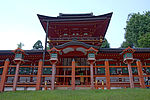| Ōhorano Shrine (大原野神社, Ōharano jinja) | |
|---|---|
 3rd Torii | |
| Religion | |
| Affiliation | Shinto |
| Deity | Takemikazuchi Himegami |
| Year consecrated | 786 |
| Location | |
| Geographic coordinates | 34°57′37″N 135°39′22″E / 34.96028°N 135.65611°E |

Ōharano Shrine (大原野神社, Ōharano jinja) is a Shinto shrine located in Nishikyō-ku, Kyoto Prefecture, Japan.
Ōharano is dedicated to the Fujiwara tutelary kami, Ame-no-Koyane, who was said to have assisted in the founding of the state.[1]
YouTube Encyclopedic
-
1/5Views:303414313369577
-
【4K】幻の桜と紅葉の名所で藤原氏の氏神を祭祀する社:京都府・大原野神社 (Ōharano Shrine | Shinto Shrine in Kyoto Prefecture)
-
The Oracle of Emperor Seiwa: founding of Iwashimizu Hachiman-gū!
-
【4K】男山の峯に座し、王城鎮護を司る社:京都府・石清水八幡宮 (Iwashimizu Hachimangū | One of the three largest Hachimangū)
-
「秋田」の語源になった北方守護の武神を祀る社:秋田県・古四王神社(Koshiō Shrine | The shrine dedicated to a warrior god)
-
【4K】京を潤し土を養う水源の社、紅葉の光景:京都府・貴船神社 (Kifune Shrine | Kyoto's Shrine of the Water Deity)
Transcription
History
The shrine became the object of Imperial patronage during the early Heian period.[2] In 965, Emperor Murakami ordered that Imperial messengers were sent to report important events to the guardian kami of Japan. These heihaku were initially presented to 16 shrines including the Ōharano Shrine.[3]
From 1871 through 1946, the Ōhorano Shrine was officially designated one of the Kanpei-chūsha (官幣中社), meaning that it stood in the second rank of government supported shrines.[4]
See also
Notes
- ^ McCullough, Helen Craig et al. (1985).Kokin Wakashu (poem 871), p. 171.
- ^ Breen, John et al. (2000). Shinto in History: Ways of the Kami, pp. 74-75.
- ^ Ponsonby-Fane, Richard Arthur Brabazon. (1962). Studies in Shinto and Shrines, pp. 116-117.
- ^ Ponsonby-Fane, Richard. (1959). The Imperial House of Japan, pp. 126.
References
- Breen, John and Mark Teeuwen. (2000). Shinto in History: Ways of the Kami. Honolulu: University of Hawaii Press. ISBN 978-0-8248-2363-4
- McCullough, Helen Craig and Tsurayuki Ki. (1985). Kokin Wakashū: The First Imperial Anthology of Japanese Poetry. Stanford: Stanford University Press. ISBN 978-0-8047-1258-3
- Ponsonby-Fane, Richard. (1962). Studies in Shinto and Shrines. Kyoto: Ponsonby Memorial Society. OCLC 399449
- ____________. (1959). The Imperial House of Japan. Kyoto: Ponsonby Memorial Society. OCLC 194887


